MODES
You will hear many people talk about the modes. They will show you formulas to create the modes. But, to date, I haven't seen one that truly shows you how the modes are comprised within the Major Scale.
I'm sure they are out there, I just haven't seen them.....yet.
The chords of the A Major Scale is A Major, B minor, C# minor, D Major, E Major, F# minor, G# Diminished.
The names of the modes are:
- I. Ionian
- ii. Dorian
- iii. Phrygian
- IV. Lydian
- V. Mixolydian
- vi. Aeolian
- vii°. Locrian
In it's simplest form, the modes of the Major Scale are simply a new starting point of the within the Major Scale.
So, if you know the Major Scale, you essentially know the modes. You only need to start on a different note, that isn't the root note (also named Tonic) of the scale.
The main difference of the modes are the "target (or home) notes". These are the notes where you land to emphasize the sound of the mode. For example, if you're playing A Ionian, the target notes, or home notes, is A. So, you will sound better if you land on the 1-3-5 (major chord formula) of the A Major Scale, but the one that will sound best will be A.
In the Dorian Mode, the target note will be B.
So, the target (or home) notes will be the 1-b3-5 (minor chord formula). Of those, the best will be the tonic, B.
When we think of a key, we think of going root (the 1 note) through the scale:
1-2-3-4-5-6-7
A mode simply means that we start at a different starting and ending point. For example, the Dorian Mode starts at the 2:
2-3-4-5-6-7-1
Is Dorian still in the main key? Yes, it is.
Do we have to switch from mode to mode depending on the chord we play over changes (underlying chord)? NO!!! We're still in the key.
Is Phrygian (3-4-5-6-7-1-2) in the key? Yes. Is Mixolydian (5-6-7-1-2-3-4) in the key? Yes. All modes are in the key.
If you’re already playing a lead using target notes from the underlying chord, you're already using modes without necessarily realizing it.
If the underlying chord is an Bm (B-D-F), the notes of the underlying chord are our target notes. There is no need to think of changing modes.
The modes of the A Major Scale are:
- A Ionian
- B Dorian
- C# Phrygian
- D Lydian
- E Mixolydian
- F# Aeolian
- G#° Locrian
If we know that each Major Key has a Relative Minor, we've already used modes. The Relative Minor is the 6th of the Major Scale.
In the case of our example, the A Major Scale, the Relative Minor (3 frets down from the Major root) is F#.
If we look at the above list, we've been playing in F# Aeolian. When we talk about Minor Keys, they are really only 6th mode (Aeolian) of the Major Scale (Ionian).
Now that we know that all Minor Keys are really just the 6th mode of the Major Key, we find out Major Scale and we know what the notes are: W-W-H-W-W-W-H
I Don't Particularly Like My Aunt Linda
"I Don't Particularly Like My Aunt Linda" is one of the many sentences to help you remember the names of the Major Scale modes. Each word starts with the first letter of the mode.
- Ionian ( I )
- Dorian (Don't)
- Phrygian (Particularly)
- Lydian (Like)
- Mixolydian (My)
- Aeolian (Aunt)
- Locrian (Linda)
Of course, it's much better to learn the actual names of the modes, and their order. But when you're beginning, it may seem like a daunting task. Something as simple as a funny sentence can help you learn the order of the modes.
If someone asks you what the name of the 5th mode is, you simply remember this sentence, and you know the 5th word is My. This means that the 5th mode starts with M. At this point, you'll probably say Mixolydian, and you are correct.
Playing Modes in the familiar Major Pattern
To show that MODES can be played in the usual standard Major Scale pattern that we all know, here are the Modes

Since all the modes belong to the Major Scale, thus you can play the modes in a familiar Major pattern.
Just simply start on a different interval that fits the mode you want to play.
That's the basics of Modes, but lets go a little deeper into it.
How do I know what Minor Mode I should play.
If you are playing in a Major or Minor Scale, the pattern is there are 3 Major Chords, and 3 Minor Chords (and a Diminished Chord).
We already mentioned that a Minor Scale is the 6th mode of the Major Scale. What happened to the other 2 Minor Chords in the Scale?
If we know that Major Scale, we already know all the notes of the Relative Minor. But, we also know all the notes of all the modes of that Major Scale.
For example, in the Key of C Major, there are no sharps or flats in the scale. The Relative Minor of C Major is Am (A minor).
As you might already know, there are no sharps or flats in the key of A Minor.
We already discussed that the Minor Key is simply the 6th Mode of the Major Scale. So, the Aeolian Mode (6th mode) has the same notes.
The only difference is the starting chord, Am vs C (Major).
The notes of C Major are: C-D-E-F-G-A-B. The notes of A Minor are: A-B-C-D-E-F-G.
They contain the same notes. The only thing that changes is the starting note, which is also called your "target" note.
In C Major, the target notes are the notes of the C Major Chord: C-E-G
In A Minor, the target notes are the notes of the A Minor Chord: A-C-E
As you might have guessed, the notes for all the modes are the same notes as the C Major Scale, just the starting point changes.
The second mode of C Major is D Dorian. The notes are: D-E-F-G-A-B-C. They are the same notes.
The same is true for all the modes.
Is it really that simple?
Yes, it really is that simple. If you're playing in D Dorian, we know Dorian is the 2nd mode of C Major.
So, we simply know the notes of the C Major Scale are C-D-E-F-G-A-B. We simply start on the 2nd interval of the scale, place the major root at the end, and continue through the rest of the scale: D-E-F-G-A-B-C.
There are a ton of videos and tutorials showing you the modes, and they are really nothing more than the notes of the Major Scale, with a new starting point.
Since I said that, you might already guess that we can just use the scale patterns we already know, and just start from a different position. Yes, you can. The target notes change, where you put emphasis, but the notes are the same. They will sound different when you start from a different interval than the root.
That's the real point of the modes. Also when playing in different modes, try to avoid you tried and true "go to" licks, that you use in the Major Scale, since they most likely target the Major (Ionian) Scale.
Play around with the different modes, and you will see they sound very different than the Major Scale.
This is simply because the intervals change in the modes, not the notes.
1. Ionian Mode ( 1, 2, 3, 4, 5, 6, 7 )
The first mode of the Major Scale is the Ionian mode. The Ionian Mode starts and ends at the root note of the Major Scale.
Does this sound familiar? It should, because it's simply another name FOR THE MAJOR SCALE.
The intervals of the Ionian Mode are: W-W-H-W-W-W-H. They are the exact intervals of the Major Scale.
The notes of the A Ionian Mode are: A - B - C# - D - E - F# - G#
The chords of the A Ionian Mode are: A - Bm - C#m - D - E - F#m - G#dim
Here is the A Major Scale
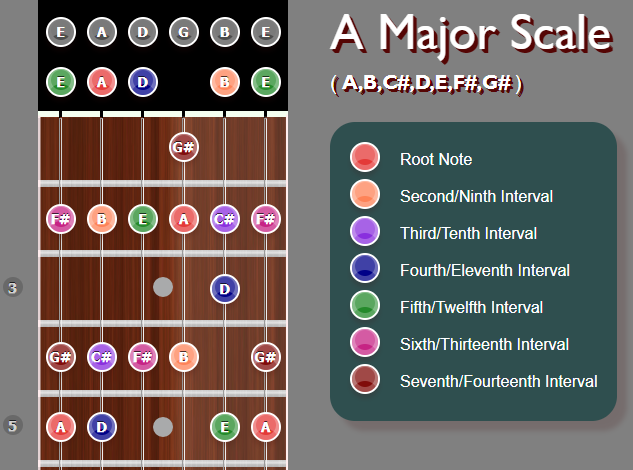
And here is the A Ionian Mode/Scale
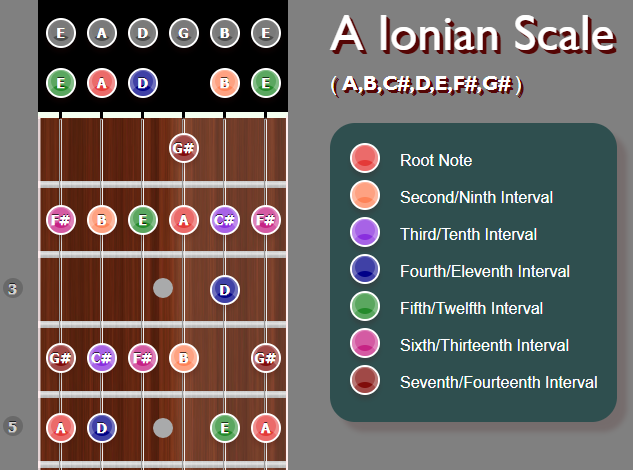
Do they look familiar? Yes, they are exactly the same.
So, now you realize that you already know the first mode of the Major Scale: Ionian.
The target, or home notes are: A - C# - E.
2. Dorian ( 1, 2, b3, 4, 5, 6, b7 )
We will be working through all these modes, based on the A Major Scale, for consistancy, and hopefully simplicity.
As we continue on to the next mode, we see that the notes of the scale are the same as the notes from the A Major Scale.
The only difference is that we take the A, the root note of A Major, and place it at the end of the scale.
The Intervals for the Dorian mode also is like starting the Major Scale pattern (W-W-H-W-W-W-H) from the second interval.
The intervals of the Dorian Mode are: W-H-W-W-W-H-W. We simply move to the second interval of the Major Scale, and start there.
The notes of the B Dorian Mode are: B - C# - D - E - F# - G# - A
The chords of the B Dorian Mode are: Bm - C#m - D - E - F#m - G#dim - A
We simply shift to the 2nd note of the A Major Scale (B), and begin our pattern there.
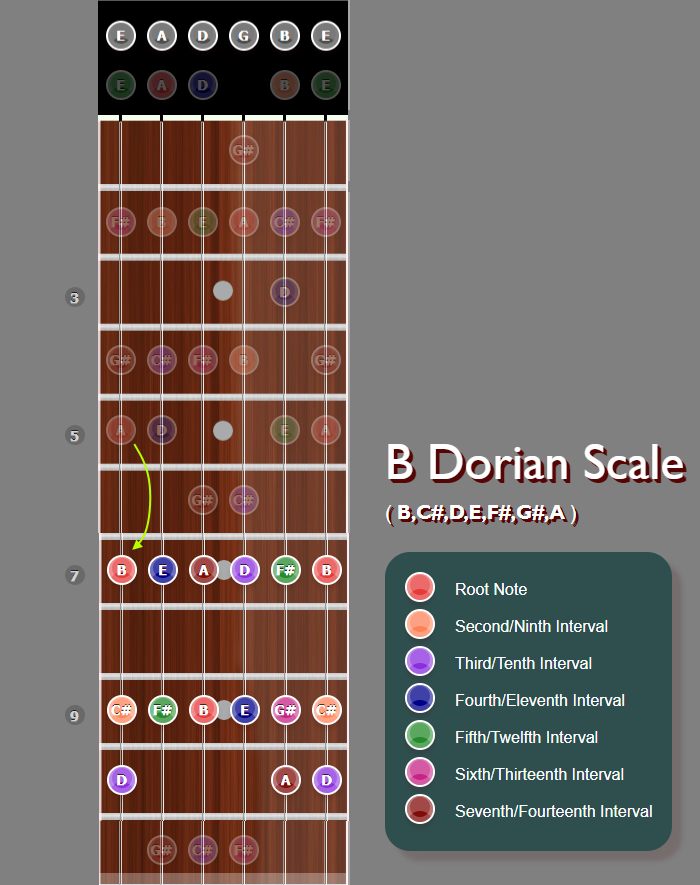
As with any scale or mode, if you play the root note, and let it ring out, and play the scale over it,
you will here hear how the scale sounds. The Dorian, over B, will have a minor flavor to it.
This happens, using the same notes as the A Major Scale, which obviously, has a Major flavor to it.
That's why the modes are important in adding some other dynamics to your playing. You use the same notes,
with different intervals, and it sounds different. With this in mind, you can play 7 different modes in any Major Scale.
Note: you can play modes over a Minor Scale also, and we will cover that in a later lesson.
The target, or home notes are: B - D - F#.
3. Phrygian ( 1, b2, b3, 4, 5, b6, b7 )
The Intervals for the Phrygian mode also is like starting the Major Scale pattern (W-W-H-W-W-W-H) from the third interval.
The intervals of the Phrygian Mode are: H-W-W-W-H-W-W. We simply move to the third interval of the Major Scale, and start there.
The notes of the B Phrygian Mode are: C# - D - E - F# - G# - A - B
The chords of the B Phrygian Mode are: C#m - D - E - F#m - G#dim - A - Bm
We simply shift to the 3rd note of the A Major Scale (C#), and begin our pattern there.
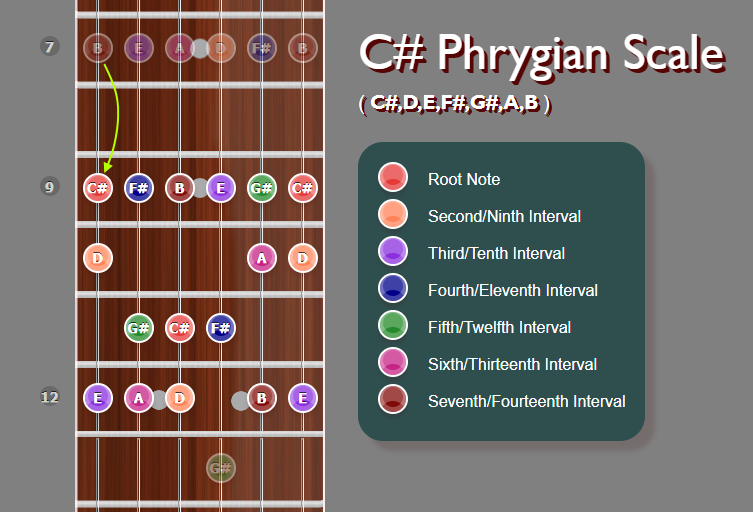
4. Lydian ( 1, 2, 3, #4, 5, 6, 7 )
The Intervals for the Lydian mode also is like starting the Major Scale pattern (W-W-H-W-W-W-H) from the fourth interval.
The intervals of the Lydian Mode are: W-W-W-H-W-W-H. We simply move to the fourth interval of the Major Scale, and start there.
The notes of the D Lydian Mode are: D - E - F# - G# - A - B - C#
The chords of the D Lydian Mode are: D - E - F#m - G#dim - A - Bm - C#m
We simply shift to the 4th note of the A Major Scale (D), and begin our pattern there.
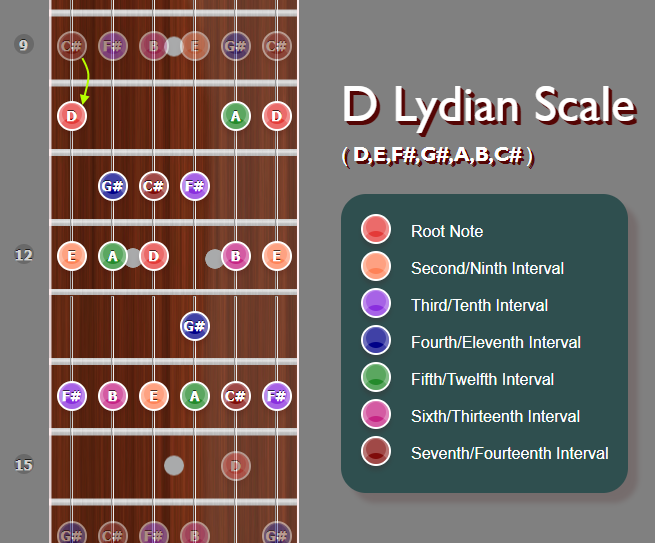
As with all scale patterns, there are more than one way to play it. But, the C# form might be easier to play.
Simply start with the D as the root note (tonic).
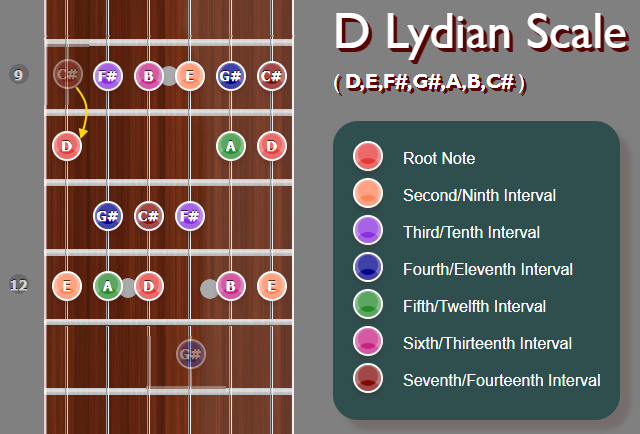
5. Mixolydian ( 1, 2, 3, 4, 5, 6, b7 )
The Intervals for the Mixolydian mode also is like starting the Major Scale pattern (W-W-H-W-W-W-H) from the fifth interval.
The intervals of the Mixolydian Mode are: W-W-H-W-W-H-W. We simply move to the fifth interval of the Major Scale, and start there.
The notes of the E Mixolydian Mode are: E - F# - G# - A - B - C# - D
The chords of the E Mixolydian Mode are: E - F#m - G#dim - A - Bm - C#m - D
We simply shift to the 5th note of the A Major Scale (E), and begin our pattern there.
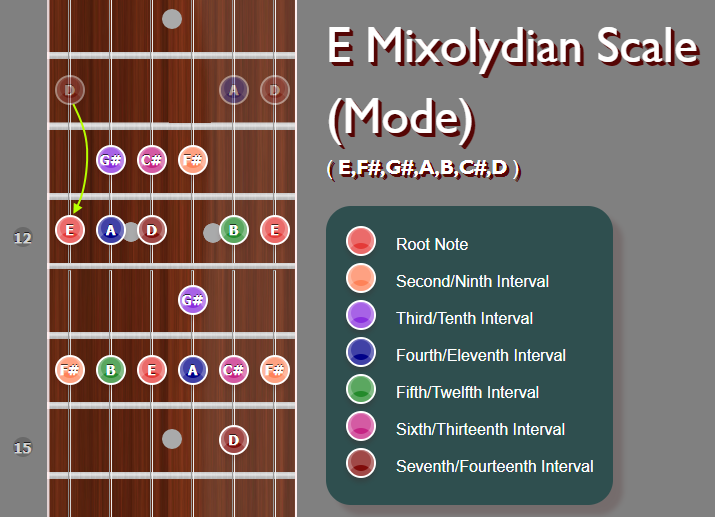
6. Aeolian ( 1, 2, b3, 4, 5, b6, b7 )
The Intervals for the Aeolian mode also is like starting the Major Scale pattern (W-W-H-W-W-W-H) from the sixth interval.
The intervals of the Aeolian Mode are: W-H-W-W-H-W-W. We simply move to the sixth interval of the Major Scale, and start there.
The notes of the F# Aeolian Mode are: F# - G# - A - B - C# - D - E
The chords of the F# Aeolian Mode are: F#m - G#dim - A - Bm - C#m - D - E
We simply shift to the 6th note of the A Major Scale (F#), and begin our pattern there.
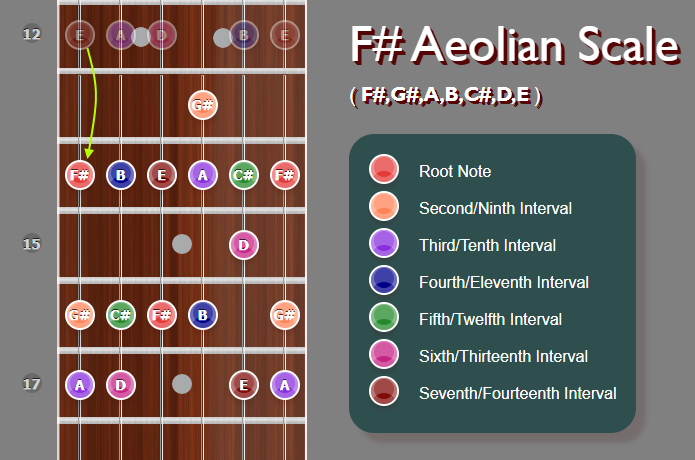
7. Locrian ( 1, b2, b3, 4, b5, b6, b7 )
The Intervals for the Locrian mode also is like starting the Major Scale pattern (W-W-H-W-W-W-H) from the seventh interval.
The intervals of the Locrian Mode are: H-W-W-H-W-W-W. We simply move to the seventh interval of the Major Scale, and start there.
The notes of the G# Locrian Mode are: G# - A - B - C# - D - E - F#
The chords of the G# Locrian Mode are: G#dim - A - Bm - C#m - D - E - F#m
We simply shift to the 7th note of the A Major Scale (G#), and begin our pattern there.
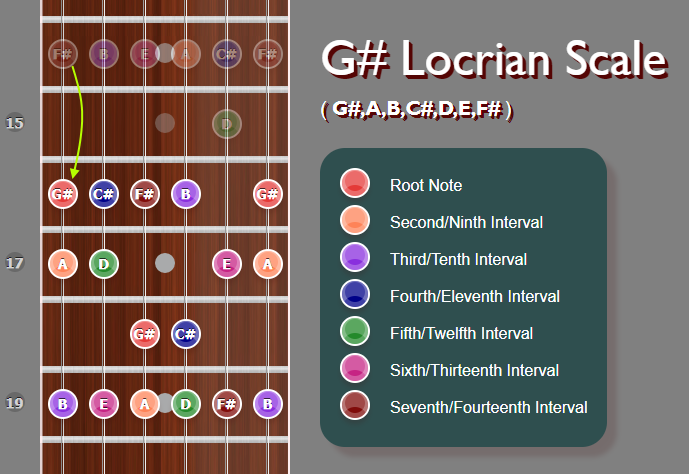
Out of all the modes, Locrian is used very rarely, because of it's harsh sound, which is strange since it uses the same notes.
So can I just use the Major Scale and Major Scale patterns that I already use for Modes?
The short answer is "YES." For each mode, just start on that interval in the Major Scale (Ionian).
So, if you're playing in the Dorian Mode, you can use the same scale patterns you know, just start on the 2nd interval. In all the above examples, we used the A Major Scale (A Ionian).
So, for Dorian, just start on the B instead of the A. Playing B to B instead of A to A
The only real downside is that you will probably use the same phrases that you use for
the Major Scale (Ionian), thus it might sound like you're playing in the Ionian Mode instead of Dorian.
Just be aware of this, and yes, you can use the existing patterns instead of the ones shown above.
Where do modes fit in?
One of the easiest ways to play your modes, and here them, is to have a backing track without a bunch of changes.
Some of your favorite solos, that switch between modes, is usually played on a backing that have a single chord, or two chord progression. This allows you to switch between modes, and still have the home base (Major Scale)
In the single chord, it's usually the root chord. In a multiple chord progression, usually the root chord is there also.
Another way to use them is over power chords, because they are neither Major nor Minor, since they don't have a 3rd.
Wrap Up
Modes are a great way to give your solos a different flare than simply using the familiar Major Scale (Ionian).
The above scale positions are shown to display how each mode is based on a different note (interval) of the Major Scale.
There are other options for scale patterns, and these can be used as well as any other patterns that you may find in your playing.
Just make sure to practice changing your current "go to" phrases in the Major Scale (Ionian), to accentuate the differences in the Mode you are playing. If you play these "go to" phrases, your solo may still sound
like it's the Major Scale (Ionian) instead of the Mode you are currently playing.